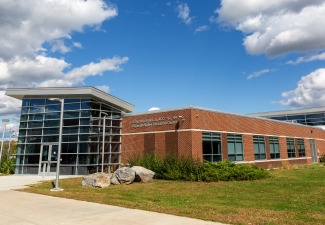Students, Faculty Form Robotics Club | SUNY Plattsburgh
A robotics club has formed at SUNY Plattsburgh, a new organization focused on experiential learning for students interested in this growing space within the engineering and computer science fields.
Jordan Flagg ’16, Justin Collins ’16 and adviser Dr. Michael Walters, assistant professor of physics, make up the PSU Robo Crew. The club was formed at the start of the spring 2016 semester.
The idea for the group came out of an introduction to robotics course, which Walters created a few years ago. He’s among a group of professors who are working to create a robotics major at SUNY Plattsburgh. A robotics minor is already offered.
The Robo Crew’s June 2016 trip to Worcester, Mass. to compete in the 2016 Sample Return Robot Challenge, sponsored by NASA, came out of Walters’s search to find an ambitious project for the students to tackle.
“I began poking around, looking for a challenge to get my students excited,” he said. “It seemed logical to jump in with both feet into a contest that could inspire those future (robotics) majors.”
For the challenge qualifier, groups aimed to build a robot that could autonomously locate and retrieve objects in a field of varied terrain.
“SUNY has been promoting experiential learning, and it doesn't get much more experiential than this,” Walters said.
The Robo Crew began building their robot in January 2016. Rahul Arora '16 assisted Flagg, Collins and Walters in creating the bot.
To keep costs down, the group repurposed materials and purchased others at low cost. The materials for the rover totaled about $3,200, thousands of dollars less than some other teams who competed in the NASA challenge.
“We worked hard on this … and all of us, including myself, learned a great deal,” Walters said.
As a dual physics and computer science major, Flagg, a Tupper Lake, N.Y. native, said he had many of the skills he needed to help the team build the robot, but he wasn’t familiar with operating a 3-D printer, so he purchased one and assembled it himself, familiarizing himself with the technology. It took him three weeks to become proficient in operating the printer, he said.
“The hardest part is configuring and calibrating and figuring all the tweaks with the software to make it a usable part,” Flagg said.
Flagg, who graduates later in 2016, is looking to work for a robotics company, possibly to work on developing artificial intelligence or self-automated drones. He hopes his experience in both software and hardware engineering will give him an edge in his job search.
“It was a really good experience and I was able to learn a lot from building that rover that I can apply to my career,” Flagg said.
The Robo Crew’s bot didn’t pass the qualification round to enter into the main competition, but that doesn’t discount the team’s work, Walters said, given that the challenge is extremely difficult.
In the previous four years of the Sample Return Robot Challenge, just two robots have qualified and gone on to complete level 1 of the competition successfully, he said.
“Time was the biggest constraint; Having such a small team and limited amount of time to work on it,” Flagg said. “If we had another couple weeks we would probably have been able to compete.”
The larger goal of their project was still met, though.
NASA’s aim in establishing the challenge was to “inspire involvement and ingenuity,” Flagg said, and through skillful teamwork and dedication, the Robo Crew accomplished that.
“It was a really awesome experience. We learned a lot about the industry and how everything we learned applies to the field we were going into,” Flagg said, adding that the group made many friends with the members of other robotics teams while at the competition.
Walters said the Robo Crew was applauded at the challenge for their perseverance and resourcefulness in using 3-D printing to develop a prototype and Flagg’s novel robotic arm design. He plans to apply for a patent for the design.
The Robo Crew gives students a venue to put their knowledge into practice, working with newly emerging technology.
“I feel the excitement and focus these challenges bring will help our students succeed not only in school, but also in their professional life,” Walters said. “This makes it an important facet of their education.”
News

SUNY Adirondack Students Benefit from New Dual Agreement with SUNY Plattsburgh Queensbury
